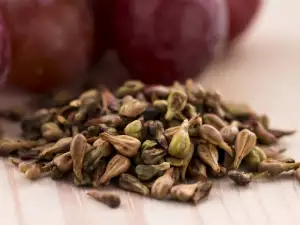When it comes to figs, we immediately think of the fleshy, sweet and delicious fruits, which are also very beneficial for health. But how many of you know about the therapeutic properties of fig leaves?
In fact, the leaves of the Common Fig (Ficus carica) are no less beneficial for health than its delicious fruits. They have long been used in folk medicine to treat a number of health problems. And in some parts of the world, fig leaves are also used to prepare various dishes.
Nutritional value
Fig leaves are rich in antioxidants and fiber. They are also a good source of vitamin A, B1 and B2. They also contain calcium, iron, phosphorus, manganese, sodium and potassium.
Culinary applications
Fig leaves are prepared steamed, baked or grilled. They can be used as a wrap and are steamed with meat, seafood and vegetables to impart a smoky, fruity flavor and a distinct coconut aroma. Additionally, fig leaves can be used to make a syrup for glazing meat, to flavor cocktails, to create jellies, baked goods and crushed fig leaves can be soaked in a cream base for ice cream.
Dried fig leaves can also be boiled and used to make tea. Fig leaves pair well with cream, coconut milk, onions, rice, fish sauce, apricots, red chilies, basil, red curry paste, pepitas, tofu, chicken, and fish. Fig leaves are highly perishable and will last 1-2 days when kept fresh in the refrigerator.
Uses in folk medicine
A medicinal tea is prepared from fig leaves, which is used in folk medicine to treat various diseases. The leaves are collected in late spring, summer or autumn. Healthy and whole leaves are selected from the tree and placed on a drying surface. They are dried in the shade, in a dark and ventilated place.
You can also tie them into a bundle and hang them in a high place. When the leaves are dry, you can tell by the fact that they shrink and crumble under your fingers when you squeeze them. To dry them faster, they can be cut shortly before drying. Once dry, cut them and store in a jar with a lid.
For health purposes, it is recommended to drink fig leaf tea every day for about a month, then take a break for a few weeks, so that repeated consumption has an equally strong healing effect. Fig leaf tea is prepared in the following way:
- In case of diabetes, 2 teaspoons of dried fig leaves are poured with a cup (200 ml) of boiling water. Cover and leave them for 10-15 minutes. Then strain. Drink one cup of this tea for breakfast every morning.

- For stomach ulcers and mouth ulcers, chew 2 tender fig leaves well every day and swallow them. In addition to helping with ulcers, it will freshen your breath and relieve unpleasant mouth ulcers.
- Help with bronchitis. Boil 3 fig leaves in water with a little brown sugar and drink the decoction.
Health benefits of fig leaves
There are many health benefits of fig leaves. Fig leaves are best known for their ability to regulate metabolism and blood sugar levels, making them indispensable for diabetes. They are also useful for colds, bronchitis, fever, ear and throat pain, inflammation, abscesses, sexually transmitted diseases and are great for liver health.
The leaves have a rich level of alkenes. In addition, they can normalize the pH of the body. These leaves are high in flavonoids and polyphenols, which are valuable antioxidants in the fight against free radicals.
For diabetes
Although the fruit is not recommended for diabetics due to its high sugar levels, fig leaves are very beneficial for this group of people, as they help regulate blood sugar levels. Fig leaves are high in potassium, which manages the amount of sugar absorbed into the body after a meal. A large amount of potassium can regulate blood sugar fluctuations, so fig leaves can help those suffering from diabetes.
Caution! If you suffer from type 1 diabetes and take insulin, consult your doctor before taking a fig leaf decoction.
For weight loss
The fiber in fig leaves reduces weight and is sometimes recommended against obesity. Fig leaf tea improves metabolism and helps to lose excess weight.
For lower cholesterol levels
Fig leaves contain pectin, which is known as a fiber that dissolves in water. When this type of fiber enters the body, it tries to clean up cholesterol residues and carry them to the urinary system to be expelled from the body.
For high triglycerides
Consumption of fig leaves helps reduce triglyceride levels in the blood, thus providing additional protection for the heart and blood vessels. Although a certain level of triglycerides is necessary for health, excess triglycerides significantly increase the risk of obesity and heart disease.
Prevention of coronary heart disease
Dried fig leaves contain phenols, omega-3 and also omega-6. These fatty acids reduce the risk of coronary heart disease.
Prevention of hypertension

People usually consume sodium in the form of salt, but reduced potassium and rich sodium levels can cause hypertension. Fig leaves are rich in potassium and with reduced sodium levels, so they are a suitable protection against hypertension.
Against constipation
Fig leaves are rich in fiber. They improve health, normal bowel movements and prevent constipation. In the meantime, you can try consuming fig leaf tea or simply eat fresh fig fruits.
Against Heartburn
Fig leaves reduce stomach acid, which is beneficial for pregnant women.
Treatment of Bronchitis
The natural compounds in fig leaves make them perfect ingredients for tea for bronchitis. Fig leaf tea is an alternative method of treating many respiratory diseases such as bronchitis and is also used as a method of avoiding and reducing the worse effects in asthma patients. Two to three fig leaves are placed in half a liter of water with a little sugar and left to boil. Let the water boil for 20 minutes and then remove the leaves and drink the tea.
Soothing Sore Throats with Fig Leaves
The rich mucilage in figs soothes sore throats. The refreshing sensation of fig leaves and their natural juices can reduce pain and infections of the vocal cords. These ingredients are important enough to treat many respiratory diseases such as dry cough and asthma.
Strengthens Bones
Fig leaves are high in calcium, which is one of the most essential substances for strengthening bones and reducing the risk of bone loss. They are also high in phosphorus, which stimulates bone formation and promotes regrowth if there is an injury or fracture.
Prevents Macular Degeneration
Vision loss in older people is usually due to macular degeneration. Fig fruits and leaves are particularly useful in slowing down this process.
In cosmetics
If the leaves are mashed, they can be used as a skin cleanser for acne and pimples.
Side effects and contraindications
Consuming too many fig leaves can cause diarrhea. In addition, dried fig leaves are rich in sugars and can increase the risk of cavities. There are also people who are sensitive to fig leaves or the unique chemicals in them.
Check out what figs are good for, how to make a fig face mask and how to dry figs.




















Comments